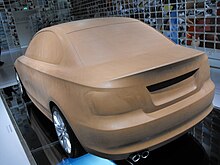| Revision as of 06:51, 15 September 2024 editCJDOS (talk | contribs)Extended confirmed users9,064 editsm →Design studios: Letter case.← Previous edit | Latest revision as of 08:43, 15 September 2024 edit undoDimadick (talk | contribs)Autopatrolled, Extended confirmed users, Pending changes reviewers806,428 edits →References | ||
| Line 29: | Line 29: | ||
| {{DEFAULTSORT:Plasticine, industrial}} | {{DEFAULTSORT:Plasticine, industrial}} | ||
| ] | ] | ||
| ] | |||
Latest revision as of 08:43, 15 September 2024
Modeling material which is mainly used by automotive design studios| This article needs additional citations for verification. Please help improve this article by adding citations to reliable sources. Unsourced material may be challenged and removed. Find sources: "Industrial plasticine" – news · newspapers · books · scholar · JSTOR (February 2024) (Learn how and when to remove this message) |


Industrial plasticine is a modeling material which is mainly used by automotive design studios. It was developed as an industrial version of Plasticine or hobby clay.
Industrial plasticine is based on wax and typically contains sulfur, which gives a characteristic smell to most artificial clays. The styled object can be used to create moulds. However, largely because sulfur interfered with some mould-making processes, especially if clay surfaces are unsealed surfaces and platinum-cure room-temperature–vulcanizing silicone was used, sulfur-free variants are now available; these are usually much lighter than sulfur-containing clays.
If a negative mold is required, this data is sent to a milling machine.
Design studios
Before a new car model is launched, a long period of creating the right design takes place. Even today, computer models are not sufficient to evaluate a design. Therefore 1:4 and then 1:1 models are built to get an impression of the final car. These models are created in clay, and usually consist of a wooden or iron frame which is covered with Styrofoam. Clay is smoothed over the foam. Modellers then use various tools and slicks to finalize the shape of the car, since changes are readily possible.
More recently, clay models are 3D scanned into a digital file using laser technology. This is then opened in computer-aided design software to be worked further.
Suppliers
There are three main producers of industrial plasticine operating worldwide:
- Staedtler, of Germany, which is also known for FIMO.
- * BOMI is located in Shanghai and is known for its production of industrial clays.
- Chavant, which was founded by the French chemist Claude Chavant and is now located in New Jersey, USA.
References
- Knoll, Wolfgang; Hechinger, Martin (2007). Architectural Models: Construction Techniques. J. Ross. ISBN 978-1-93-215996-7.
- ^ Hallgrimsson, Bjarki (6 March 2023). Prototyping and Modelmaking for Product Design. Quercus Publishing. ISBN 978-1-52-943203-9.